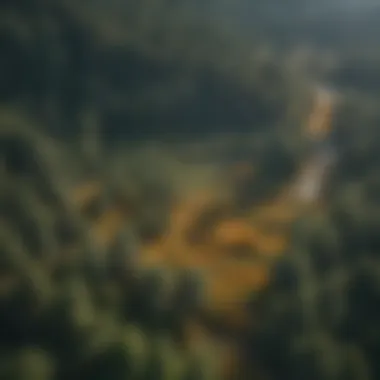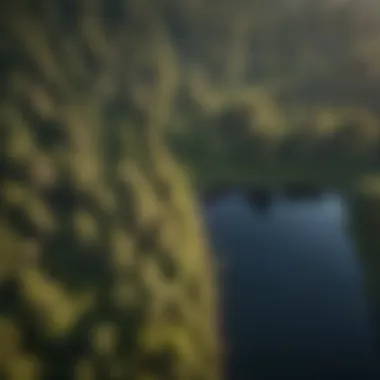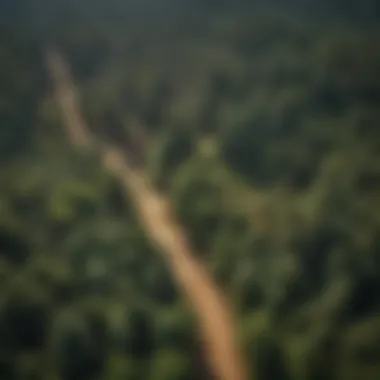Exploring Airborne Remote Sensing in Forestry


Intro
In today's world where environmental concerns are at the forefront, the role of airborne remote sensing in forestry cannot be overstated. This powerful tool not only enhances our understanding of forest ecosystems but also contributes significantly to sustainable practices in woodland management. The integration of technologies like Lidar and multispectral imaging allows for intricate data collection and analysis that are essential for maintaining the health of our forests.
To navigate this complex landscape, it is crucial to have a thorough grasp of forestry practices and how modern technology intersects with traditional management methods. By examining established practices and innovative techniques, especially through the lens of airborne sensing, we uncover valuable insights that inform decision-making processes aimed at forest preservation and enhancement.
Throughout this article, we will explore:
- The importance of effective forestry practices
- The principles that underpin sustainable woodland management
- Cutting-edge technological advancements that support data-driven decision
- The crucial blend of traditional expertise with modern methodologies
Let’s embark on this journey to unravel the significance of airborne remote sensing in forestry and understand its transformative potential.
Preamble to Airborne Remote Sensing
Airborne remote sensing is becoming increasingly pivotal in the field of forestry. As climate change, urbanization, and other anthropogenic pressures continue to threaten forest ecosystems, innovative technologies like airborne remote sensing offer tools that can illuminate the path to management and conservation.
This technology not only helps in resource inventory but also provides critical insights into forest health, biodiversity, and the impact of land use changes. This section delves into the essence of airborne remote sensing, offering a clear understanding of its benefits and historical context.
Definition and Overview
Airborne remote sensing refers to the collection of data regarding the Earth's surface from aircraft or drones equipped with various sensors. These sensors are capable of capturing images and other pertinent information, which can then be analyzed to monitor and manage forest resources effectively. The data obtained provides significant insights into the physical characteristics of forests, such as tree height, canopy cover, and species composition.
The real charm of airborne remote sensing lies in its ability to cover vast areas in a fraction of the time traditional ground surveys would require. This not only saves invaluable resources but also allows for more frequent monitoring. Simply put, it marries the sky's wide view with ground-level detailed data—offering forestry professionals a comprehensive toolkit for understanding forest dynamics.
Historical Context and Evolution
To grasp the current significance of airborne remote sensing in forestry, it's crucial to look back at its evolution. The roots can be traced back to World War II, when aerial photography became a standard tool for military reconnaissance. Post-war, the technology began finding its way into civilian applications, including agriculture and forestry.
In the late 20th century, with advancements in sensor technology, the focus shifted to specialized devices like Lidar and multispectral cameras. As these instruments grew more sophisticated, so did their capabilities. For instance:
- Lidar (Light Detection and Ranging) debuted as a game-changer by enabling precise topographic mapping and vegetation analysis.
- Multispectral imaging followed, allowing for the analysis of different wavelengths of light, which is instrumental in assessing plant health and species identification.
The integration of drones into this space has further transformed the landscape. Their nimbleness and accessibility have democratized airborne data collection, making it possible for even small-scale operations to leverage advanced sensing technologies without breaking the bank.
The technological advancements in airborne remote sensing have provided a lens through which we can view the complexities of forest ecosystems, making it an invaluable tool for modern forestry management.
As this brief historical overview illustrates, airborne remote sensing in forestry is not a fleeting trend; it's a testament to our capacity for innovation in response to pressing environmental challenges. It brings us closer to fostering sustainable forests, understanding biodiversity, and ultimately enhancing ecosystem health.
Technologies in Airborne Remote Sensing
Airborne remote sensing plays a pivotal role in modern forestry practices, providing essential tools for monitoring and assessing forest resources. Understanding the technologies behind this method allows professionals to leverage its capabilities efficiently. By distinguishing between various technologies, their applications, strengths, and limitations can be examined. Lidar, multispectral imaging, and drone-based systems are at the forefront of this field, each offering unique functionalities that address the diverse needs of forestry management.
Lidar Technology
Principles of Lidar Operation
Lidar, or Light Detection and Ranging, is a groundbreaking technology that uses laser light to measure distances. The basic operation involves emitting a pulse of light that travels to the ground and reflects back to the sensor. This time-of-flight measurement provides accurate distance readings, producing high-resolution topographical maps. One distinct characteristic of Lidar is its ability to penetrate through canopy cover, making it an invaluable tool in gathering data where traditional surveying methods struggle.
- The speed of data acquisition and processing is swift, making it a popular choice among forestry professionals.
- It excels in mapping terrains and identifying vegetation structures accurately.
However, the technology does have some constraints, such as its dependence on a clear atmosphere to function optimally. Moreover, while it captures detailed data, interpreting this data demands specialized skills and software, which can be a barrier for some users.
Applications in Forest Inventory
In forestry, Lidar's impact on forest inventory is profound. By utilizing Lidar systems, professionals can create three-dimensional representations of forests, detailing tree heights, canopy density, and even species distribution. The precision offered by Lidar allows for more accurate biomass estimations and carbon stock assessments. This characteristic makes Lidar a beneficial tool in the growing field of ecological studies and resource management.
Some advantages of Lidar's application in forest inventory include:
- High accuracy in structural analysis, which is critical for sustainable management.
- Capability to conduct assessments over large areas relatively quickly.
Nevertheless, costs associated with the technology and the required training for its effective application can pose challenges for smaller forestry operations.
Multispectral and Hyperspectral Imaging
Spectral Signatures of Vegetation
Multispectral and hyperspectral imaging involves capturing reflected light from objects, allowing for identification and classification of various vegetation types. Each species reflects light uniquely across different wavelengths, creating a spectral signature. This technology is advantageous as it facilitates identification of plant species and health assessment by analyzing these signatures. The ability to capture data across numerous bands provides a deeper understanding of the forest ecosystem.
One significant feature of spectral signatures is that they can detect stress indicators in plants, often before visual symptoms are apparent. This makes them an invaluable selection for proactive forest management strategies. Both technologies can aid in predicting how vegetation responds to environmental changes.


However, they can also face challenges, such as high data volume that requires significant computational power for analysis. Furthermore, distinct atmospheric conditions can influence the accuracy of the reflectance data captured.
Monitoring Forest Health Indicators
Monitoring forest health is increasingly important as environmental changes take toll on ecosystems. Utilizing multispectral and hyperspectral imaging can provide critical insights into the condition of forests. This technology allows early detection of pest infestations, disease outbreaks, or drought stress, which is essential for effective management responses.
The major attributes of this technological approach are:
- Ability to conduct on-going monitoring of ecosystems with relative ease.
- Potential to gather data for longitudinal studies, improving understanding of dynamic ecosystem responses.
Nonetheless, it might require coordination among multiple data sources and specialists to interpret the complex datasets, leading to a steeper learning curve for newcomers.
Drone-Based Remote Sensing
Advantages of Drones in Forestry
The rise of drone technology in forestry is a game changer. Drones provide an economical and efficient means to gather data from above. They can be outfitted with various sensors to capture multispectral images, Lidar data, or thermal information, depending on the needs of the assessment. One key advantage of using drones is their ability to cover inaccessible or rugged terrain, which can be a significant hurdle for ground-based methods.
Presumably, the cost-effectiveness and flexibility make drones a popular and beneficial choice for forestry applications. They can be deployed quickly and often allow for hours of flying time, covering vast areas with minimal human presence.
This shift towards drone usage does come with its complexities. Regulations surrounding airspace can limit their usage in certain areas, requiring users to be well-versed in local laws. Moreover, maintenance and the need for trained personnel to operate the systems can add layers of complexity.
Data Collection Processes
The data collection processes involved in drone-based remote sensing are vital to understanding how these systems can be effectively utilized in forestry. Drones can be programmed to fly predetermined paths, capturing data in a systematic way that provides comprehensive insights. This method proves to be particularly essential in forest inventory, health monitoring, and ecosystem assessments.
Drones allow for the gathering of real-time data, presenting a significant advantage in decision-making processes. The unique feature of drone-based data collection is its rapid responsiveness, enabling forest managers to act quickly based on the information received.
However, a challenge lies in the variability of sensor quality and functionality. Not all drones offer the same capabilities, which may affect the quality and type of data collected. Training personnel to interpret this data correctly is also essential, as poor analysis can lead to misguided management decisions.
Applications of Airborne Remote Sensing in Forestry
Airborne remote sensing plays a pivotal role in modern forestry practices. The ability to capture, analyze, and interpret data from above transforms how we manage and preserve forestry resources. Its significance unfolds in various applications within the field, providing insights that were previously hard to achieve with ground-based methods alone. This section will delve into key areas where airborne remote sensing shines, illustrating its benefits and considerations.
Forest Inventory and Assessment
Mapping Tree Distribution
Mapping tree distribution is one of the foundational aspects of airborne remote sensing in forestry. By using advanced imaging technologies, forestry professionals can effectively identify where different tree species are located across a landscape. This mapping is not just about counting trees; it's about understanding their distribution patterns and how they change over time.
The most notable characteristic of mapping tree distribution lies in its spatial accuracy. High-resolution imagery, especially from Lidar, allows for pinpointing tree locations with clarity. This is crucial for forest management efforts, as knowing the exact distribution aids in planning harvesting operations and conservation initiatives.
A unique feature of mapping tree distribution is its ability to provide a comprehensive overview of biodiversity within forest ecosystems. This allows for the identification of critical habitats, which is particularly beneficial in conservation planning. However, it's important to acknowledge that one downside is the significant volume of data generated, which can require advanced processing and interpretation techniques.
Estimating Biomass and Carbon Stocks
Estimating biomass and carbon stocks represents a key application that connects forestry practices with climate change mitigation. This process entails calculating the amount of organic matter in trees and forests, which directly relates to the ecosystem's ability to sequester carbon.
The core characteristic of this application is its relevance to global climate policies. Accurate estimations provide vital data for understanding how forests act as carbon sinks. With proper analysis, forestry practitioners can assess how management practices affect overall carbon storage, influencing policy decisions on climate action.
One unique aspect of estimating biomass is that it fosters collaboration between ecologists, foresters, and climatologists. This interdisciplinary approach enhances the credibility of forest management strategies. Nevertheless, the complexity of the calculations can sometimes lead to variance in data interpretation, which might complicate the communication of findings.
Monitoring and Managing Forest Health
Detection of Pests and Diseases
Detecting pests and diseases in forests is essential for maintaining ecosystem health, and airborne remote sensing is particularly adept at this task. This method allows for the monitoring of large areas quickly, making it easier to spot potential issues before they escalate.
A key feature of this application is its proactive nature. Early detection can lead to timely interventions that mitigate damage, which is more cost-effective than remedial measures after a problem has spread. Remote sensing can reveal subtle changes in vegetation health, suggesting pest infestations or disease outbreaks.
The unique aspect of using airborne remote sensing for pest and disease detection is the ability to utilize specific spectral signatures. These signatures often differ from healthy vegetation, allowing for precise identification of affected areas. However, it’s worth noting that the interpretation of such data can sometimes be hampered by environmental noise or overlapping signatures from different stressors.
Assessing Environmental Stress Factors
The ability to assess environmental stress factors is one of the most critical applications of airborne remote sensing in maintaining the health of forest ecosystems. This includes monitoring changes due to drought, pollution, or even extreme weather events.
A vital characteristic of this application is its focus on real-time monitoring. With the right technology, changes in forest health can be recorded continuously, allowing for timely response to emerging threats. This ongoing assessment helps in understanding the broader implications of climate variability on forest systems and informs necessary management adjustments.
When it comes to unique features, the combination of remote sensing data with ground-truthing activities provides a robust understanding of stress factors. However, fluctuating weather and atmospheric conditions can sometimes limit data quality, making consistent assessment a challenge.
Land Use and Land Cover Changes


Impact of Urbanization on Forest Zones
Urbanization poses significant threats to forest zones, and airborne remote sensing tools have become indispensable in monitoring these changes. The encroachment of cities into forested areas can lead to fragmentation, loss of habitat, and overall biodiversity decline.
A critical aspect of this application is its ability to visualize and quantify land use changes over time. High-resolution imagery allows for the detection of urban spread and its impact on surrounding forested lands. This helps stakeholders understand trends and project future urban growth with forest preservation in mind.
One unique contribution of remote sensing in this context includes providing historical comparisons, helping to establish patterns of urban expansion affecting forest zones. While it is highly effective, a potential disadvantage lies in the need for comprehensive regulatory frameworks to manage these changes properly.
Identifying Deforestation Patterns
Identifying deforestation patterns through airborne remote sensing is crucial for understanding the dynamics of forest loss. With the pressing global emphasis on sustainability, knowing where and how deforestation occurs helps in crafting effective management strategies.
The key characteristic of this application is its capacity to cover vast areas and produce reliable data at a fraction of the time it would take using ground-based assessments. This rapid analysis can help detect illegal logging activities, which is a growing concern worldwide.
A unique feature of deforestation pattern identification includes the ability to analyze temporal changes. This allows for the monitoring of trends over time, providing insights into the effectiveness of policies aimed at curbing deforestation. Nevertheless, one challenge that remains is ensuring that the detected changes correspond to true deforestation, as natural fluctuations can sometimes be misinterpreted as human activities.
Advantages and Limitations
Airborne remote sensing presents various benefits and drawbacks that must be thoroughly examined, especially in the context of forestry. Understanding both sides is crucial, as it allows forestry professionals to make informed decisions about integrating these technologies into their practices. By weighing the advantages against the limitations, one can appreciate the full spectrum of what airborne remote sensing can offer.
Benefits of Airborne Remote Sensing
High Spatial and Temporal Resolution
One of the standout features of airborne remote sensing is its high spatial and temporal resolution. This means that it can capture details at an impressive scale, providing clearer, more precise images of forest areas than various ground methods could achieve. With high resolution, you can identify individual tree species, map boundaries more accurately, and even monitor specific areas over time with unrivaled clarity.
This characteristic proves beneficial in real-time monitoring, enabling forest managers to track changes in their resources. The ability to revisit the same location frequently allows them to observe seasonal variations or impacts from disturbances like wildfires or storms. However, it’s crucial to balance this advantage with the need for appropriate technology and expertise to interpret such detailed data efficiently.
Cost-Effectiveness Compared to Ground Surveys
Another significant advantage lies in the cost-effectiveness compared to ground surveys. When you consider the traditional methods of surveying large forest areas, the expenses add up quickly. Personnel, equipment, and time all factor into a hefty price tag. Airborne remote sensing can drastically reduce these costs by covering vast expanses in a fraction of the time and for less money.
Moreover, utilizing these technologies can minimize human resources required on the ground, lessening the risk of errors or oversight in data collection. That said, while airbone methods might save costs, they can require substantial initial investment in equipment and training.
Challenges and Limitations
Data Processing and Interpretation Issues
Despite its advantages, airborne remote sensing does come with data processing and interpretation issues. Collecting vast amounts of data is one thing, but efficiently processing and making sense of it is another challenge altogether. Without the right analysis techniques, invaluable information might be lost or misinterpreted, ultimately affecting decision-making in forest management.
The technology itself often requires sophisticated software and specialist knowledge to interpret the data accurately. As a result, if there aren’t enough trained professionals available, it could lead to bottlenecks in research and application. While it's a powerful tool, the intricacies of data analysis shouldn't be underestimated.
Environmental Factors Affecting Data Quality
Another critical aspect to consider is environmental factors affecting data quality. Conditions like cloud cover, atmospheric disturbances, and even foliage density can significantly hinder the accuracy of aerial observations. These factors may obscure or distort the data collected, leading to potential misjudgments in assessing forest health or biodiversity.
Understanding these limitations is vital as forestry professionals endeavor to adopt this technology. Planning data collection around weather conditions and seasonal changes fosters better data reliability. However, limitations remain an inherent part of using airborne remote sensing, and awareness is key to mitigating their impacts.
Interpreting Data from Airborne Remote Sensing
Interpreting data obtained from airborne remote sensing is pivotal for making informed decisions in forestry management. As these technologies gather vast amounts of information—ranging from forest structure to health indicators—the analysis of this data significantly impacts ecological understanding and resource management.
The insights drawn from this data not only help in managing existing forests but also aid in planning for future conservation efforts. It's not simply about collecting numbers and images; it’s about weaving a narrative from that raw data which can guide actions and policies.
Moreover, interpretation involves employing various techniques that allow forestry professionals to visualize patterns, detect changes, and understand complex forest dynamics. In essence, interpreting this data is like reading between the lines of nature’s script, where each data point tells its own story about the surrounding ecosystem.
Data Analysis Techniques
Geospatial Analysis Tools
Geospatial analysis tools play an essential role in interpreting remote sensing data by providing the necessary framework to visualize and analyze spatial relationships and data patterns. These tools can process and map complex datasets, enabling professionals to convert aerial imagery into comprehensive maps that display critical information such as vegetation types, tree density, and health conditions. A key characteristic of geospatial analysis tools is their ability to integrate multiple data layers, offering a multi-dimensional view of the forested area.
One unique feature of these tools is their dynamic modeling ability, which allows users to simulate scenarios or predict future changes in the environment. The benefits are substantial; for example, users can quickly gauge how interventions might impact carbon sequestration or biodiversity. However, they do come with disadvantages, particularly regarding the steep learning curve associated with advanced tools. Those not well-versed in geospatial technologies can find them quite daunting.
Machine Learning Applications
Machine learning applications in the interpretation of airborne remote sensing data bring a fresh perspective on how we analyze forest environments. These algorithms can identify patterns and anomalies in extensive datasets that would be impossible for humans to discern without assistance. A major advantage of employing machine learning is the efficiency in processing large data volumes over traditional methods.
Unique to machine learning applications is their capacity for continual learning. As more data is fed into the system, the algorithms become better at making predictions and identifying trends. This adaptability often translates to timely insights, especially critical during crisis events like pest invasions or natural disasters. However, one downside is the reliance on quality data; poor input can lead to incorrect interpretations, potentially resulting in misguided management strategies.


Case Studies in Data Usage
Successful Forest Restoration Projects
Successful forest restoration projects often utilize data derived from airborne remote sensing to guide their initiatives. These projects highlight the application and necessity of real-time data in assessing restoration needs and monitoring progress. A key characteristic that makes these projects stand out is their reliance on baseline data collected pre-restoration, allowing for a side-by-side comparison and evaluation of the impact over time.
One unique aspect of these projects is the ability to visualize the success of replanting efforts. By tracking changes over time using aerial imagery, stakeholders can showcase the effectiveness of their interventions, encouraging further investment and participation. Nonetheless, challenges exist; the need for multi-year studies can slow down immediate results that funding agencies often seek.
Long-Term Ecological Monitoring Programs
Long-term ecological monitoring programs represent a highly systematic approach to gathering and analyzing data over extended periods. Such programs help in establishing trends and assessing the ongoing health of forests. The key characteristic of these programs is their structured approach to data collection, ensuring consistency across varying seasons and years.
A standout feature is that these programs enable researchers to observe slow-moving ecological changes which might otherwise be missed in short-term studies. They serve as critical tools for validating management strategies and understanding climate impacts on forested ecosystems. However, the challenge here is the resources needed to maintain such long-term monitoring can be substantial, often requiring continued funding and collaboration among various agencies.
In summary, the interpretation of airborne remote sensing data encompasses a variety of techniques and impacts, each contributing to a greater understanding of our forest ecosystems. It enables forestry professionals to act thoughtfully and strategically, ensuring that our forest resources are managed sustainably for future generations.
"The right interpretation of data can mean the difference between thriving ecosystems and environmental degradation."
Future Trends in Airborne Remote Sensing
The development of airborne remote sensing is on a fast track, showing no signs of slowing anytime soon. This topic is crucial as it shapes how forestry professionals approach forest management, conservation efforts, and data collection methods. Several key elements stand out, such as advances in sensing technology and the role of remote sensing in climate change mitigation. These trends can greatly influence decision-making processes and promote sustainable practices in forestry.
Advances in Sensing Technology
Integration of AI and Remote Sensing
One of the exciting frontiers is the integration of artificial intelligence (AI) into remote sensing technologies. This advancement enhances the ability to analyze massive datasets quickly and accurately. Notably, machine learning algorithms can sift through remote sensing data, pinpointing critical indicators of forest health or changes in land cover. The key characteristic of this integration lies in its ability to offer real-time insights.
Why is AI such a popular choice in this context? Primarily, it optimizes resource management by enhancing predictive models; this helps identify potential issues before they escalate.
A unique feature of AI integration is its capacity for continuous learning and improvement. As more data becomes available, these models get better at resolving complexities that may human analyses could miss. The drawbacks might be the initial cost of implementation and the requirement for specialized knowledge, but the advantages typically far outweigh these.
Emerging Sensor Technologies
Emerging sensor technologies are also making waves in airborne remote sensing. These new sensors — such as miniaturized Lidar units and compact multispectral cameras — bring a fresh perspective to forest analytics. They make it feasible to gather data at finer scales while reducing the logistical challenges traditionally linked with remote sensing deployments. Key characteristics include lightweight designs and enhanced resolution.
Their popularity among forestry professionals can be attributed to their cost-effectiveness and ease of deployment. For example, using smaller drones equipped with these sensors allows for extensive data collection over challenging terrain without hefty budget implications.
The unique feature of these cutting-edge sensors is their flexibility. They adapt to different forestry needs, from wildlife habitat monitoring to carbon stock assessments. However, one must consider that rapid technological advancement can lead to a steep learning curve for users unfamiliar with these tools.
Role in Climate Change Mitigation
Monitoring Carbon Sequestration
One significant contribution of airborne remote sensing lies in monitoring carbon sequestration. Understanding how forests capture and store carbon is crucial for developing strategies to combat climate change. The essential characteristic of this monitoring is its ability to provide comprehensive data on biomass and forest composition.
Why is this monitoring so beneficial in this context? Accurate assessments can guide reforestation efforts, helping identify which areas have the highest carbon storage potential.
A unique feature of this monitoring method is the capability for high-frequency data collection. This allows forestry professionals to observe changes over time, essential for adapting management practices. Challenges may include varying data accuracy depending on weather conditions, but the overall advantages make it a valuable tool for climate initiatives.
Impact Assessments for Policy Development
Impact assessments for policy development represent another vital role in climate change mitigation. This evaluation provides decision-makers with data-driven insights into how forestry practices can affect climate outcomes. Key characteristics of these assessments include their ability to assess risks and benefits of various land management strategies.
Why is this critical for forestry? Insightful assessments can lead to the formulation of effective policies aimed at reducing deforestation or revitalizing degraded lands.
A unique aspect of impact assessments is their reliance on comprehensive datasets from various sources, including remote sensing technologies. Though challenging, the integration of these datasets can provide nuanced, multi-faceted perspectives on potential policies. This complexity can be a deterrent for some professionals, but it also represents an opportunity for innovation in merging diverse scientific inputs to guide policies for sustainable forestry management.
Finale
As we draw this exploration of airborne remote sensing in forestry to a close, it’s crucial to understand the significant impact this technology has on woodland management and environmental stewardship. The advancements in aerial monitoring are not just academic—they hold tangible benefits, directly influencing how we manage and conserve our forest resources. This technology provides a multi-faceted view of forest health, aiding in the identification of issues that often remain hidden at ground level.
Reflections on Airborne Remote Sensing
Reflecting on the journey through this topic, we see that airborne remote sensing is more than just a tool; it’s a pivotal player in shaping the future of forestry. With technologies like Lidar and multispectral imaging, professionals are equipped to gather precise data that informs better decision-making. These methods enhance our ability to assess tree health, monitor biomass, and understand the complex dynamics of ecosystems.
Moreover, the adaptability of airborne remote sensing methods allows for their application across various forestry contexts—from urban forestry where accurate planning is crucial to conservation efforts in remote wilderness areas. Such flexibility makes these technologies vital allies in the ongoing battle against deforestation and environmental degradation.
"Data-driven insights from airborne remote sensing can illuminate paths to a more sustainable future, revealing hidden problems before they escalate."
The Path Forward for Forestry Management
Looking ahead, the path for forestry management is increasingly intertwined with innovations in remote sensing. The integration of artificial intelligence into data analysis processes can streamline operations and enhance accuracy in assessments. Moreover, as sensor technology advances, the potential for capturing finer details at larger scales will revolutionize how we understand our forests.
Forestry practitioners must consider not only the immediate application of these technologies but also the long-term implications for conservation and policy development. Implementing best practices based on robust data creates a feedback loop that can drive sustainable practices across the board.
In summary, as we embrace the digital age in forestry, airborne remote sensing stands at the forefront, driving change and fostering resilience in forest management. It’s not just about keeping track of numbers on a map. It’s about making informed decisions that can secure the health of our forests for generations to come.















